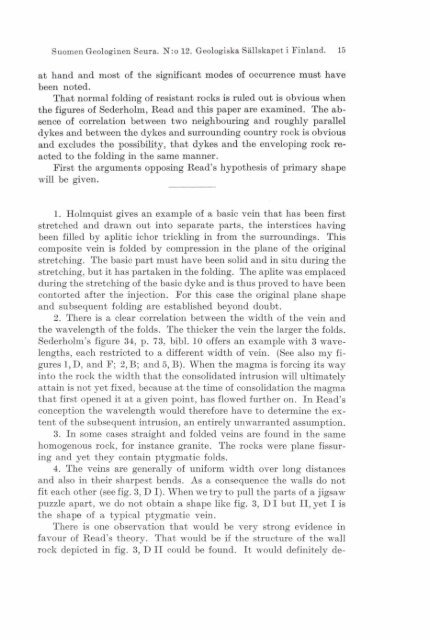GOHMISSION GEOLOGIQVE - Arkisto.gsf.fi
GOHMISSION GEOLOGIQVE - Arkisto.gsf.fi
GOHMISSION GEOLOGIQVE - Arkisto.gsf.fi
Create successful ePaper yourself
Turn your PDF publications into a flip-book with our unique Google optimized e-Paper software.
Suomen Geologinen Seura. N:o 12. Geologiska Sallskapet i Finland. 15<br />
at hand and most of the signi<strong>fi</strong>cant modes of occurrence must have<br />
been noted.<br />
That normal folding of resistant rocks is ruled out is obvious when<br />
the <strong>fi</strong>gures of Sederholm, Read and this paper are examined. The absence<br />
of correlation between two neighbouring and roughly parallel<br />
dykes and between the dykes and surrounding country rock is obviow<br />
and excludes the possibility, that dykes and the enveloping rock reaoted<br />
to the folding in the same manner.<br />
First the arguments opposing Read's hypothesis of primary shape<br />
will be given.<br />
1. Holmquist gives an example of a basic vein that has been <strong>fi</strong>rst<br />
stretched and drawn out into separate parts, the uiterstices having<br />
been <strong>fi</strong>lled by aplitic ichor trickling in from the surroundings. This<br />
composite vein is folded by compression in the plane of the original<br />
stretching. The basic part must have been solid and in situ during the<br />
stretching, but it has partaken in the folding. The aplite was emplaced<br />
during the stretching of the basic dyke and is thus proved to have been<br />
contorted after the injection. For this case the original plane shape<br />
and subsequent folding are established beyond doubt.<br />
2. There is a clear correlation between the width of the vein and<br />
the wavelength of the folds. The thicker the vein the larger the folds.<br />
Sederholm's <strong>fi</strong>gure 34, p. 73, bibl. 10 offers an example with 3 wavelengths,<br />
each restricted to a different width of vein. (See also my <strong>fi</strong>gures<br />
1, D, and F; 2,B; and Ei, B). When the magma is forcing its way<br />
into the rock the width that the consolidated intrusion will ultimately<br />
attain is not yet <strong>fi</strong>xed, because at the time of consolidation the magma<br />
that <strong>fi</strong>rst opened it at a given point, has flowed further on. In Read's<br />
conception the wavelength would therefore have to determine the extent<br />
of the subsequent intrusion, an entirely unwarranted assumption.<br />
3. In some cases straight and folded veins are found in the same<br />
homogenous rock, for instance granite. The rocks were plane <strong>fi</strong>ssuring<br />
and yet they contain ptygmatic folds.<br />
4. The veins are generally of uniform width over long distances<br />
and also in their sharpest bends. As a consequence the walls do not<br />
<strong>fi</strong>t each other (see <strong>fi</strong>g. 3, D 1). When we try to pull the parts of a jigsaw<br />
puzzle apart, we do not obtain a shape like frg. 3, D 1 but II, yet 1 is<br />
the shape of a typical ptygmatic vein.<br />
There is one observation that would be very strong evidence in<br />
favour of Read's theory. That would be if the structure of the wall<br />
rock depicted in <strong>fi</strong>g. 3, D II could be found. It would de<strong>fi</strong>nitely de-
















